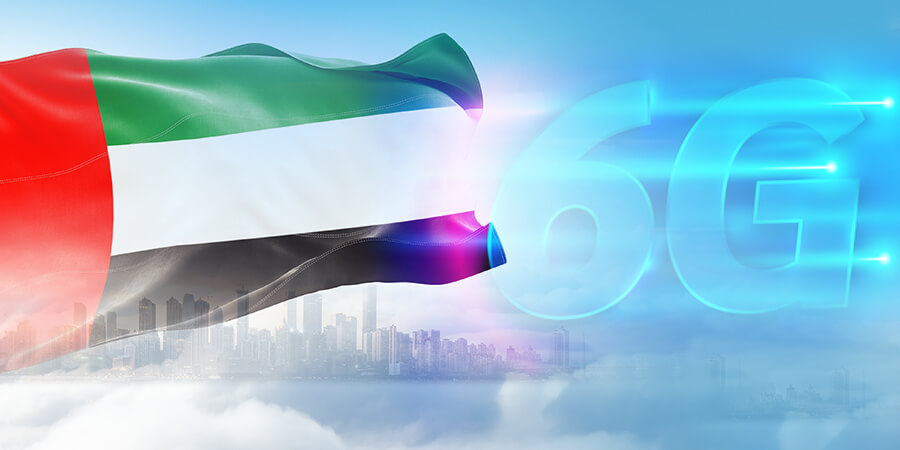As the first in the Arab region to deploy 5G network technology, the United Arab Emirates (UAE) is poised to maintain its technological leadership by pioneering the rollout of 6G networks before 2030.
In doing so, the UAE aims to cement its position at the forefront of global technological innovation, enhancing the quality of life of its residents while driving economic growth and competitiveness.
Building upon 5G and 5G-Advanced (5G-A) developments, 6G’s transformative capabilities will usher the world into a new era of intelligence, far surpassing the capabilities of current technologies.
As we stand on the cusp of another technological leap, the UAE is leveraging the capabilities of existing technologies and the power of strategic collaborations to pioneer the innovation and deployment of 6G.
Read: The Race to 6G: What’s Coming in 2025 and Beyond?
Unlocking New Possibilities with 6G Technology
The 5G to 6G transition represents a quantum leap in connectivity, promising to revolutionize industries and reshape the digital communication landscape.
IMT-2030, or 6G technology, is poised to become the primary mobile technology in the 2030s, significantly supporting the advancements in advanced artificial intelligence (AI), robotics, and immersive extended reality (XR) experiences.
Its advent promises to revolutionize connectivity and digital experiences in ways previously limited to science fiction. Not only will it enhance user experiences (UX) but also facilitate seamless communication between individuals and devices, establishing a hyper-connected ecosystem.
In the 6G era, it will be common for devices to be seamlessly embedded in clothing, enabling continuous connectivity and smart functionality. Networks will be more predictive, anticipating user needs and preferences with accuracy, and holographic telepresence will transform the global workplace. Real-time 4D maps, smart contact lenses and haptics, and breakthroughs in augmented and virtual reality (AR/VR) technologies will also ensue.
This next-generation network will seamlessly integrate the physical and virtual realms and support groundbreaking applications. Interestingly, 6G technology is expected to facilitate the digital transmission of human senses, including taste, touch, and smell, unlocking new possibilities across various industries, particularly healthcare.
It will also ensure the large-scale integration of the Internet of Things (IoT), creating a hyper-connected environment that will support innovative applications including autonomous vehicle (AV) networks, smart cities, and industrial automation.
One of the most anticipated features of 6G technology is the advent of real-time holographic communication, which will transcend traditional communication methods. This will allow people to remotely experience and convey both their physical presence and emotions in real-time 3D.
Moreover, 6G will drive the deployment of mobile robot swarms and drones across various sectors such as hospitality, warehousing, and package delivery, leading to increased efficiency. Digital twins are also poised to evolve, simulating complex systems.
Also Read: From Low to Very Low: Transforming Earth Orbit Satellite Networks with 6G
The UAE’s 6G Roadmap
Building on its status as one of the world’s most 5G-ready nations, the UAE is leveraging its technological prowess to become a pioneer in 6G development and deployment.
The UAE’s Telecommunications and Digital Government Regulatory Authority (TDRA) stands at the forefront of accelerating the country’s advancements in the digital landscape. Building on the success of its 5G deployment, the TDRA unveiled its comprehensive 6G roadmap in 2024, outlining a strategic approach to 6G research and development (R&D). The TDRA has also announced the allocation of the 600 MHz and 6 GHz frequency bands for international mobile telecommunication (IMT) systems, supporting advanced technologies crucial for developing smart cities, IoT, AI, and Fourth Industrial Revolution (4IR) applications.
The country has established multiple centers of excellence (CoE) to cement its status as a global hub for 6G innovation, including the Khalifa University 6G Research Center, Khalifa University Center for Cyber-Physical Systems (C2PS), Emirates ICT Innovation Center (EBTIC), Artificial Intelligence and Digital Security Research Center (Technology Innovation Institute), Big Data Analytics Center established by the United Arab Emirates University (UAEU), National Space Science and Technology Center, Center for Artificial Intelligence and Robotics at NYU-Abu Dhabi, and AI Software R&D Center. These centers aim to attract global talent and investments, fostering a robust ecosystem for 6G development.
To accelerate 6G innovation, the country is actively engaging with global partners, including the Institute of Electrical and Electronics Engineers (IEEE), the 3rd Generation Partnership Project (3GPP), and the International Telecommunications Union (ITU) to establish policies and regulations for 6G deployment, including spectrum allocation, licensing frameworks, and regulatory best practices.
In 2024, UAE-based telecom operator, e&, collaborated with Ericsson to explore 6G foundations, such as cognitive networks, enhanced compute fabric, and sustainable connectivity.
Additionally, e& is exploring 6G-enabling technologies, such as reconfigurable intelligent surfaces (RIS) for high frequency (HF) bands.
Recently, Nokia and du collaborated to form a structured framework for 6G research, involving field trials, proof-of-concept (PoC) demonstrations, and research on key 6G enablers.
Read More: 6G Leading the Global Market: Forging New Opportunities
Driving Sustainability amid Technological Advancements
The UAE’s 6G roadmap strategically integrates sustainability goals, aiming to significantly reduce the UAE’s carbon footprint and energy consumption. This commitment aligns with global efforts to curb the environmental impact of next-generation wireless technologies.
According to the TDRA’s ‘6G: Next-Generation Connectivity in the UAE’ report, the UAE has set a target to cut the average power consumption in 6G networks by half compared to 5G networks, while simultaneously supporting peak capacities ten times higher. This vision reflects the UAE’s commitment to both technological innovation and environmental responsibility.
To support these sustainability goals, 6G networks will scale down capacity when the demand is low, optimizing energy consumption. This next-generation network will also be able to turn off specific frequencies during lower-traffic periods to reduce the number of operating cells.
Beyond network efficiency, 6G will connect vehicles and optimize traffic flow, potentially reducing carbon emissions in the transportation industry. Smart factories driven by 6G will also advance energy and water monitoring and management.
By including sustainability in its 6G roadmap, the UAE is cementing itself as a leader in environmental responsibility amid technological advancements. This will further support the UAE’s broader sustainability initiatives, such as the Net Zero 2050 strategy.
Read More: TDRA Aims to Pioneer 6G Services Before 2030 in UAE
Final Thoughts
The UAE’s 6G approach not only reinforces its commitment to digital transformation but also positions it as a key player in shaping the future of global connectivity.
By advancing R&D, fostering international collaborations, and aligning with global sustainability goals, the UAE is establishing a robust ecosystem that drives innovation across all sectors.
As the UAE accelerates its goal to deploy 6G technology before 2030, it is setting new benchmarks for technological innovation in the Middle East and beyond. This ambitious vision positions the UAE as a global technological leader, demonstrating its commitment to enhancing the quality of life of its residents while driving economic growth in the digital age.
More on 6G Technology:
Etisalat embarks on its 6G journey
6G: UAE's Roadmap to a More Advanced World
6G Will Become the Network of Sensing, Says Nokia’s Mikko Lavanti









